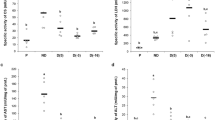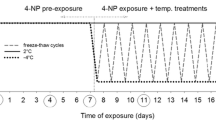Summary
The effects of extracellular freezing on intracellular metabolism were monitored over both a short (9 h) and long (12 weeks) time course using the freeze tolerant larvae of the gall fly,Eurosta solidaginis.
The process of freezing, monitored over the short time course, had no effect upon cellular energy levels (adenylates, arginine phosphate) but initiated a rise in glucose-6-P and lactate levels. This suggests that freezing initiates a shift towards glycolysis as the predominant mode of energy production. The process of thawing at 3°C (after 24 h at −16°C) also had no effect, even transient, on cellular energy levels demonstrating that thawing and the rapid redistribution of water and solutes which must accompany it does not disrupt cellular metabolism. During thawing accumulated lactate was quickly cleared with a t 1/2 of 20–30 min.
Long term freezing at −16°C had dramatic effects on energy metabolism. Freezing for up to 1 week had minimal effects with only a small drop in arginine phosphate reserves and an increase in lactate content noted. Between 1 and 2 weeks of freezing, however, larvae showed strong signs of energy stress. The arginine phosphate pool fell from 75% to 30% of control levels, ATP content dropped by 50% and energy charge dropped to 0.75. This state, with continued lactate accumulation, was maintained through 4 weeks of freezing. Between 6 and 12 weeks of freezing energy stress became even greater. Phosphagen and ATP contents dropped to 5 and 25% of control values and energy charge decreased to about 0.50. Despite this stress, however, 94% of larvae survived 12 weeks of freezing with an 86% hatch rate of adults. The data demonstrate that the larvae can survive prolonged periods of winter freezing drawing upon glycolysis and phosphagen reserves to supply the continued basal energy demands of the cell.
Similar content being viewed by others
References
Morrissey RE, Baust JG (1976) The ontogeny of cold tolerance in the gall fly,Eurosta solidaginis. J Insect Physiol 22:431–437
Somme L (1978) Nucleating agents in the haemolymph of third instar larvae ofEurosta solidaginis. (Fitch) (Dipt., Tephritidae). Norw J Ent 25:187–188
Storey KB, Storey JM (1981) Biochemical strategies of overwintering in the gall fly larva,Eurosta solidaginis: Effect of low temperature acclimation on the activities of enzymes of intermediary metabolism. J Comp Physiol 144:191–199
Storey JM, Storey KB (1983) Regulation of cryoprotectant metabolism in the overwintering gall fly larva,Eurosta solidaginis: Temperature control of glycerol and sorbitol levels. J Comp Physiol 149:495–502
Storey KB, Baust JG, Storey JM (1981a) Intermediary metabolism during low temperature acclimation in the overwintering gall fly larva,Eurosta solidaginis. J Comp Physiol 144:183–190
Storey KB, Baust JG, Buescher P (1981b) Determination of water ‘bound’ by soluble subcellular components during low temperature acclimation in the gall fly larva,Eurosta solidaginis. Cryobiology 18:315–321
Zachariassen KE (1980) The role of polyols and nucleating agents in cold-hardy beetles. J Comp Physiol 140:227–234
Author information
Authors and Affiliations
Rights and permissions
About this article
Cite this article
Storey, J.M., Storey, K.B. Freezing and cellular metabolism in the gall fly larva,Eurosta solidaginis . J Comp Physiol B 155, 333–337 (1985). https://doi.org/10.1007/BF00687475
Accepted:
Issue Date:
DOI: https://doi.org/10.1007/BF00687475




